Related Research Articles

Evangelicalism, evangelical Christianity, or evangelical Protestantism, is a worldwide trans-denominational movement within Protestant Christianity that maintains the belief that the essence of the Gospel consists of the doctrine of salvation by grace alone, solely through faith in Jesus's atonement. Evangelicals believe in the centrality of the conversion or "born again" experience in receiving salvation, in the authority of the Bible as God's revelation to humanity, and in spreading the Christian message. The movement has long had a presence in the Anglosphere before spreading further afield in the 19th, 20th and early 21st centuries.
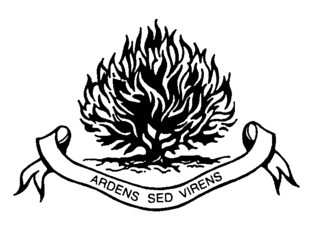
Presbyterianism is a part of the Reformed tradition within Protestantism, which traces its origins to Great Britain, specifically Scotland.

In English church history, a Nonconformist was a Protestant who did not "conform" to the governance and usages of the established Church of England. Broad use of the term was precipitated after the Restoration of the British monarchy in 1660, when the Act of Uniformity 1662 re-established the opponents of reform within the Church of England. By the late 19th century the term specifically included the Reformed Christians, plus the Baptists and Methodists. The English Dissenters such as the Puritans who violated the Act of Uniformity 1559—typically by practising radical, sometimes separatist, dissent—were retrospectively labelled as Nonconformists.
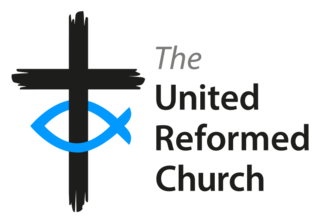
The United Reformed Church (URC) is a Protestant Christian church in the United Kingdom. It has approximately 46,500 members in 1,383 congregations with 608 active ministers, including 13 church related community workers.

Congregational churches are Protestant churches in the Reformed tradition practising congregationalist church governance, in which each congregation independently and autonomously runs its own affairs.
A dissenter is one who dissents (disagrees) in matters of opinion, belief, etc.
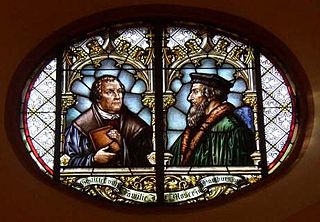
A united church, also called a uniting church, is a church formed from the merger or other form of church union of two or more different Protestant Christian denominations.
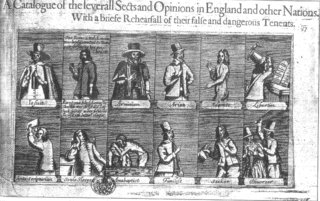
English Dissenters or English Separatists were Protestant Christians who separated from the Church of England in the 17th and 18th centuries.
The Congregational Christian Churches were a Protestant Christian denomination that operated in the U.S. from 1931 through 1957. On the latter date, most of its churches joined the Evangelical and Reformed Church in a merger to become the United Church of Christ. Others created the National Association of Congregational Christian Churches or joined the Conservative Congregational Christian Conference that formed earlier in 1945. During the forementioned period, its churches were organized nationally into a General Council, with parallel state conferences, sectional associations, and missionary instrumentalities. Congregations, however, retained their local autonomy and these groups were legally separate from the congregations.
The Evangelical and Reformed Church (E&R) was a Protestant Christian denomination in the United States. It was formed in 1934 by the merger of the Reformed Church in the United States (RCUS) with the Evangelical Synod of North America (ESNA). A minority within the RCUS remained out of the merger in order to continue the name Reformed Church in the United States. In 1957, the Evangelical and Reformed Church merged with the majority of the Congregational Christian Churches (CC) to form the United Church of Christ (UCC).
The Conservative Congregational Christian Conference is an evangelical Protestant Christian denomination in the United States.
The Congregational Union of England and Wales brought together churches in England and Wales in the Congregationalist tradition between 1831 and 1966.
The dissenting academies were schools, colleges and seminaries run by English Dissenters, that is, those who did not conform to the Church of England. They formed a significant part of England's educational systems from the mid-seventeenth to nineteenth centuries.

Protestantism is a form of Christianity that originated with the 16th-century Reformation, a movement against what its followers perceived to be errors in the Catholic Church. Protestants reject the Roman Catholic doctrine of papal supremacy and sacraments, but disagree among themselves regarding the real presence of Christ in the Eucharist, and matters of ecclesiastical polity and apostolic succession. They emphasize the priesthood of all believers; justification by faith alone rather than by good works; the teaching that salvation comes by divine grace or "unmerited favor" only, not as something merited ; and affirm the Bible as being the sole highest authority, rather than also with sacred tradition. The five solae summarise basic theological differences in opposition to the Catholic Church.

Scottish religion in the eighteenth century includes all forms of religious organisation and belief in Scotland in the eighteenth century. This period saw the beginnings of a fragmentation of the Church of Scotland that had been created in the Reformation and established on a fully Presbyterian basis after the Glorious Revolution. These fractures were prompted by issues of government and patronage, but reflected a wider division between the Evangelicals and the Moderate Party. The legal right of lay patrons to present clergymen of their choice to local ecclesiastical livings led to minor schisms from the church. The first in 1733, known as the First Secession and headed by figures including Ebenezer Erskine, led to the creation of a series of secessionist churches. The second in 1761 led to the foundation of the independent Relief Church.

Scottish religion in the nineteenth century includes all forms of religious organisation and belief in Scotland in the 19th century. This period saw a reaction to the population growth and urbanisation of the Industrial Revolution that had undermined traditional parochial structures and religious loyalties. The established Church of Scotland reacted with a programme of church building from the 1820s. Beginning in 1834 the "Ten Years' Conflict" ended in a schism from the established Church of Scotland led by Dr Thomas Chalmers known as the Great Disruption of 1843. Roughly a third of the clergy, mainly from the North and Highlands, formed the separate Free Church of Scotland. The evangelical Free Church and other secessionist churches grew rapidly in the Highlands and Islands and urban centres. There were further schisms and divisions, particularly between those who attempted to maintain the principles of Calvinism and those that took a more personal and flexible view of salvation. However, there were also mergers that cumulated in the creation of a United Free Church in 1900 that incorporated most of the secessionist churches.

The evangelical revival in Scotland was a series of religious movements in Scotland from the eighteenth century, with periodic revivals into the twentieth century. It began in the later 1730s as congregations experienced intense "awakenings" of enthusiasm, renewed commitment and rapid expansion. This was first seen at Easter Ross in the Highlands in 1739 and most famously in the Cambuslang Wark near Glasgow in 1742. Most of the new converts were relatively young and from the lower groups in society. Unlike awakenings elsewhere, the early revival in Scotland did not give rise to a major religious movement, but mainly benefited the secession churches, who had broken away from the Church of Scotland. In the late eighteenth century and early nineteenth century the revival entered a second wave, known in the US as the Second Great Awakening. In Scotland this was reflected in events like the Kilsyth Revival in 1839. The early revival mainly spread in the Central Belt, but it became active in the Highlands and Islands, peaking towards the middle of the nineteenth century. Scotland gained many of the organisations associated with the revival in England, including Sunday Schools, mission schools, ragged schools, Bible societies and improvement classes.

Scottish Protestant missions are organised programmes of outreach and conversion undertaken by Protestant denominations within Scotland, or by Scottish people. Long after the triumph of the Church of Scotland in the Lowlands, Highlanders and Islanders clung to a form of Christianity infused with animistic folk beliefs and practices. From 1708 the Scottish Society for the Promotion of Christian Knowledge (SSPCK) began working in the area. In 1797 James Haldane founded the non-denominational Society for the Propagation of the Gospel at Home. Dozens of lay preachers, divinity students and English preachers were sent to the region. In the early nineteenth century a variety of organisations were formed to support evangelism to the region.
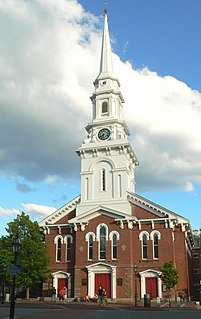
Congregationalism in the United States consists of Protestant churches in the Reformed tradition that have a congregational form of church government and trace their origins mainly to Puritan settlers of colonial New England. Congregational churches in other parts of the world are often related to these in the United States due to American missionary activities.
References
- 1 2 3 4 Paterson, Alan. "A Scottish Congregationalism" (PDF). Hamilton URC. Retrieved 27 November 2019.
- 1 2 Larsen, Timothy; Ledger-Lomas, Michael (2017). The Oxford History of Protestant Dissenting Traditions. Oxford: Oxford University Press. pp. 44, 53. ISBN 0199683719.
- ↑ The Cambridge History of Christianity. 9. Cambridge: Cambridge University Press. 2006. p. 64. ISBN 0521815002.